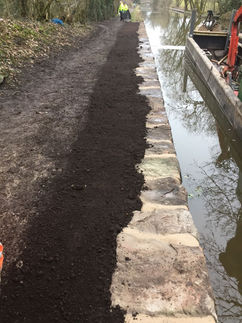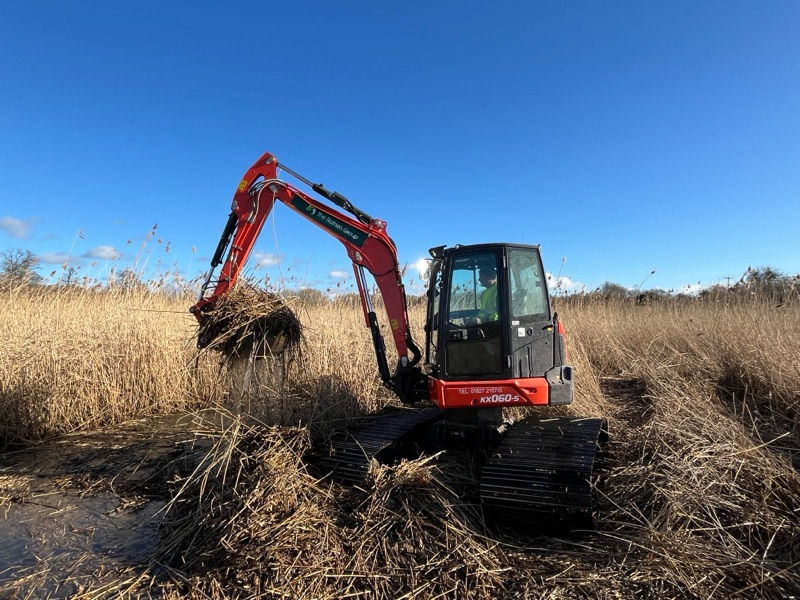
Sandbag Walling
Stabilise banks without disrupting heritage. Fast to install and built to last — a proven solution for soft canal banks and collapsed washwalls.
Bank Protection Services
Our Specialist Sandbag Walling Services
Restoring and maintaining canal banks in heritage and conservation sites doesn’t have to entail large-scale disruption. The Rothen Group installs sandbag retaining walls along canals and waterways where the stonework has failed or where an affordable, traditional solution is necessary.
Sandbag walling offers a simple yet cost-effective method for stabilising canal banks, repairing washwalls, and controlling erosion. The sandbags can be used alone or alongside other materials like coping stones or sheet piling to reinforce collapsed sections and prevent further slippage.
We’ve installed sandbag walling as part of numerous canal repair projects, including over 220 metres of washwall repair on the Macclesfield canal – all completed while keeping the canal and towpath operational. Due to their simplicity, we can rapidly construct sandbag walls – perfect as a temporary or emergency solution. However, they can form a long-lasting option when paired with other materials.
Need fast, heritage-sensitive canal repairs? Contact The Rothen Group for expert advice and a free site assessment.


Gallery

FEATURED CASE STUDY
Habitat Creation Coney Meadows, Droitwich
Coney Meadows is part of a nationwide project to restore the UK’s wetlands. Since the 17th century, large areas of reedbeds have been stripped and converted into agricultural land, massively reducing the number of habitats available for wetland animals.

FEATURED CASE STUDY
Changing the Shape of the River Derwent, Derby
Following the storm seasons of 2023 & 2024, the EA set out to review its impact on the UK’s waterways. The River Derwent in Derby was flagged after a sonar scan of its navigation identified a scour hole – a direct result of heavy rainfall pushing sediment downstream.
Sandbag walling is a common method for building or reinforcing canal banks. It involves using stacked, filled sandbags, which are laid flat on top of one another in a row. The bags are arranged similarly to brickwork and form a strong and secure barrier.
We often use sandbags to control erosion, stabilise collapse edges, and carry out sympathetic repairs in conservation and heritage areas. They’re low-impact, low-cost, and, best of all, environmentally friendly.
What is sandbag walling?
Sandbag walling can serve two purposes:
Rapid canal repairs are needed when a low-lying bank collapses or begins to slip. It can serve as a temporary measure before more robust and load-bearing materials can be installed.
Canal bank erosion control often relies on sandbags, particularly in areas where stone washwalls have failed or modern materials like concrete or piling aren’t suitable due to heritage restrictions.
Sandbag retaining walls can protect short sections of canal or extend across full stretches, depending on the repair needs. The method remains the same and can be installed swiftly compared to other techniques.
Where is sandbag walling effective?
Yes. While often considered temporary, if properly installed, sandbag walls using geotextile-lined or reinforced bags are extremely robust and durable. If paired with coping stones or other stabilisation methods, they can serve as a strong barrier for years or even decades to come, depending on the site’s conditions.
Are sandbags suitable for long-term use?
Yes. In fact, it’s relatively rare to install sandbags without using any other materials. If the sandbags are left exposed, there’s a risk that the bags can burst or become ripped, releasing the sand into the environment. That’s why we usually combine sandbags with sheet piling, gabions, or coping stones to restore structural integrity, improve the appearance, and extend the lifespan of the repair.
Usually, the canal bank is dug out, and a sandbag wall is constructed above and below the waterline. The sandbags are then topped with earth and coping stones to secure them in place and reduce damage. In sections where the bank has a greater risk of slippage, sheet piling or gabions may be added.
Can sandbag walling be used alongside other materials?
While sandbags weren’t part of original canal construction — which relied on puddle clay, stone, or timber — they’re now widely used in heritage-sensitive repairs. Their low impact and traditional appearance make them ideal for conservation settings.
Were sandbags used in original canal construction?
FAQ
Your Questions Answered
contract services
Related services
about us
A decade of
The Rothen Group
The Rothen Group delivers practical, cost-effective solutions for canal and riverbank protection across the UK. With decades of experience in waterway infrastructure, we install sandbag walling as part of both routine maintenance and complex heritage repair projects.
We’ve worked on live canal systems, conservation sites, and heritage areas — including large-scale washwall repairs — delivering high-quality results with minimal disruption. Our team understands how to balance structural needs with environmental and aesthetic sensitivity, ensuring every installation is built to last and fit for its setting.















